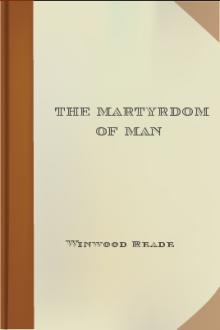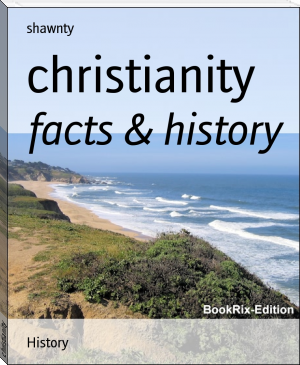The Martyrdom of Man by Winwood Reade (mini ebook reader .TXT) 📕

- Author: Winwood Reade
- Performer: -
Book online «The Martyrdom of Man by Winwood Reade (mini ebook reader .TXT) 📕». Author Winwood Reade
of iron, with nothing to be seen but their flaming eyes. The
trumpets flourished: “Laissez aller!,” cried a voice; and the
knights, with their long spears in rest, dashed furiously
against each other, and then plied battle-axe and sword, to the
great delight and contentment of the populace.
In times of war the castle was also the refuge of the poor, and
the villagers fled behind its walls when the enemy drew near.
They did not then reflect that it was the castle which had
provoked the war; they viewed it only as a hospitable fortress
which had saved their lives. It was therefore, in many cases,
regarded by the people not only with awe and veneration, but
also with a sentiment of filial love. It was associated with
their pleasures and their security. But in course of time a
rival arose to alienate the affections, or to strengthen the
resentment of the castle serfs. It was the Town.
In the days of the Republic and in the first days of the
Empire, all kinds of skilled labour were in the hands of
slaves: in every palace, whatever was required for the
household was manufactured on the premises. But before the
occupation of the Germans, a free class of artisans had sprung
up, in what manner is not precisely known; they were probably
the descendants of emancipated slaves. This class, divided into
guilds and corporations, continued to inhabit the towns: they
manufactured armour and clothes they travelled as pedlars about
the country, and thus acquired wealth, which they cautiously
concealed, for they were in complete subservience to the castle
lord. They could not leave their property by will, dispose of
their daughters in marriage, or perform a single business
transaction without the permission of their liege. But little
by little their power increased. When war was being waged, it
became needful to fortify the town; for the town was the
baron’s estate, and he did not wish his property to be
destroyed. When once the burghers were armed and their town
walled they were able to defy their lord. They obtained
charters, sometimes by revolt, sometimes by purchase, which
gave them the town to do with it as they pleased; to elect
their own magistrates, to make their own laws, and to pay their
liege-lord a fixed rent by the year instead of being subjected
to loans and benevolences, and loving contributions. The Roman
Law, which had never quite died out, was now revived; the old
municipal institutions of the Empire were restored. Unhappily
the citizens often fought among themselves, and towns joined
barons in destroying towns. Yet their influence rapidly
increased, and the power of the castle was diminished. Whenever
a town received privileges from its lord, other towns demanded
that the same rights should be embodied in their charters, and
rebelled if their request was refused. Trade and industry
expanded; the products of burgher enterprise and skill were
offered in the castle halls for sale. The lady was tempted with
silk and velvet; the lord, with chains of gold, and Damascus
blades, and suits of Milan steel; the children clamoured for
the sweet white powder which was brought from the countries of
the East. These new tastes and fancies impoverished the nobles.
They reduced their establishments; and the discarded retainers,
in no sweet temper, went over to the Town.
And there were others who went to the Town as well. In
classical times the slaves were unable to rebel with any
prospect of success. In the cities of Greece every citizen was
a soldier: in Rome an enormous army served as the slave police.
But in the scattered castle states of Europe, the serfs could
rise against their lords, and often did so with effect. And
then the Town was always a place of refuge: the runaway slave
was there welcomed; his pursuers were duped or defied; the file
was applied to his collar; his blue blouse was taken off; his
hair was suffered to grow; he was made a burgher and a free
man. Thus the serfs had often the power to rebel, and always
the power to escape; in consequence of which they ceased to be
serfs and became tenants. In our own times we have seen
emancipation presented to slaves by a victorious party in the
House of Commons, and by a victorious army in the United
States. It has, therefore, been inferred that slavery in Europe
was abolished in the same manner, and the honour of the
movement has been bestowed upon the Church. But this is reading
history upside down. The extinction of villeinage was not a
donation but a conquest: it did not descend from the court and
the castle; it ascended from the village and the town. The
Church, however, may claim the merit of having mitigated
slavery in its worst days, when its horrors were increased by
the pride of conquest and the hostility of race. The clergy
belonged to the conquered people, whom they protected from
harsh usage to the best of their ability. They taught as the
Moslem doctors also teach, and as even the pagan Africans
believe, that it is a pious action to emancipate a slave. But
there is no reason to suppose that they ever thought of
abolishing slavery, and they could not have done so had they
wished. Negro slavery was established by subjects of the Church
in defiance of the Church. Religion has little power when it
works against the stream, but it can give to streams a power
which they otherwise would not possess, and it can unite their
scattered waters into one majestic flood.
Rome was taken and sacked but never occupied by the barbarians.
It still belonged to the Romans: it still preserved the
traditions and the genius of empire. Whatever may have been the
origin of British or Celtic Christianity, it is certain that
the English were converted by the Papists; the first Archbishop
of Canterbury was an Italian; his converts became missionaries,
entered the vast forests of pagan Germany, and brought nations
to the feet of Rome. The alliance of Pepin and the Roman See
placed also the French clergy under the dominion of the Pope,
who was acknowledged by Alcuin, the adherent of Charlemagne, to
be the “Pontiff of God, vicar of the apostles, heir of the
fathers, prince of the Church, guardian of the only dove
without stain.”
The ordinance of clerical celibacy increased the efficacy of
the priesthood and the power of the Pope. The ranks of the
clergy were recruited, generation after generation, from the
most intelligent of the lay men in the lower classes, and from
those among the upper classes who were more inclined to
intellectual pursuits than to military life. These men, divided
as they were from family connections, ceased to be Germans,
Englishmen, or Frenchmen, and became catholic or universal
hearted men, patriots of religion, children of the Church. And
those enthusiastic laymen who had adopted an ascetic isolated
life, or had gathered together in voluntary associations; those
hermits and monks, who might have been so dangerous to the
Established Church, were welcomed as allies. No mean jealousy
in the Roman Church divided the priest and the prophet, as
among the ancient Jews; the mullah and the dervish, as in the
East at the present time. The monks were allowed to preach, and
to elect their own monastery priests; they were gradually
formed into regular orders, and brought within the discipline
of ecclesiastic law. The monks of the East, who could live on a
handful of beans, passed their lives in weaving baskets, in
prayer and meditation. But the monks of the West, who lived in
a colder climate, required a different kind of food; and as at
first they had no money, they could obtain it only by means of
work. They laboured in the fields in order to live and that
which had arisen from necessity was continued as a part of the
monastic discipline. There were also begging friars, who
journeyed from land to land. These were the first travellers in
Europe. Their sacred character preserved their lives from all
robbers, whether noble or plebeian, and the same exemption was
accorded to those who put on the pilgrim’s garb. The smaller
pilgrimage was that to Rome the greater that to the Holy Land,
by which the palmers obtained remission of their sins, and also
were shown by the monks of Egypt, Sinai, and Palestine, many
interesting relics and vestiges of supernatural events. They
were shown the barns which Joseph had built, vulgarly called
the Pyramids; the bush which had burnt before Moses and was not
consumed, and the cleft out of which he peeped at the “back
parts” of Jehovah; the pillar of salt which was once Lot’s
wife, and which, though the sheep continually licked it out of
shape, was continually restored to its pristine form; the ruins
of the temple which Samson overthrew; the well where Jesus used
to draw water for his mother when he was a little boy, and
where she used to wash his clothes; the manger in which he was
born, and the table on which he was circumcised; the caves in
which his disciples concealed themselves during the
crucifixion, and the cracks in the ground produced by the
earthquake, which followed that event; the tree on which Judas
hanged himself, and the house in which he resided, which was
surrounded by the Jews with a wall that it might not be injured
by the Christians.
It was not only the rich who undertook this pilgrimage; many a
poor man begged his way to the Holy Land. When such a person
was ready to depart, the village pastor clad him in a cloak of
coarse black serge, with a broad hat upon his head, put a long
staff in his hand, and hung round him a scarf and script. He was
conducted to the borders of the parish in solemn procession,
with cross and holy water the neighbours parted from him there
with tears and benedictions. He returned with cockle-shells
stitched in his hat, as a sign that he had been across the
seas, and with a branch of palm tied on to his staff, as a sign
that he had been to Jerusalem itself. He often brought also
relics and beads; a bag of dust to hang at the bedside of the
sick; a phial of oil from the lamp which hung over the Holy
Sepulchre, and perhaps a splinter of the true cross.
When the Saracens conquered Palestine and Egypt, they did not
destroy the memorials of Jesus, for they reverenced him as a
prophet. Pious Moslems made also the pilgrimage to Jerusalem;
and the Christians were surprised and edified to see the
turbaned infidels removing their sandals like Moses on Mount
Sinai, and prostrating themselves upon the pavement before the
tomb. The caliphs were sufficiently enlightened to encourage
and protect the foreign enthusiasts who filled the land with
gold; and although the palmers were exempt from “passage” and
“pontage” and other kinds of blackmail levied by the barons on
lay travellers, they found it more easy and more safe to travel
in Asia than in Europe. The passion for the pilgrimage to
Palestine, which had gradually increased since the days of
Helena and Jerome, burst forth as an epidemic at the close of
the tenth century. The thousand years assigned in Revelation as
the lifetime of the earth were about to expire. It was believed
that Jesus would appear in Jerusalem, and there hold a grand
assize: thousands bestowed their property upon the Church, and
crowded to the Holy Land.
While they thus lived at Jerusalem and waited for the second
coming, continually looking up at the sky and expecting it to
open, there came instead a host of men with yellow faces and
oblique slit-shaped





Comments (0)